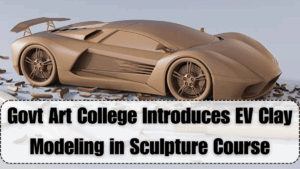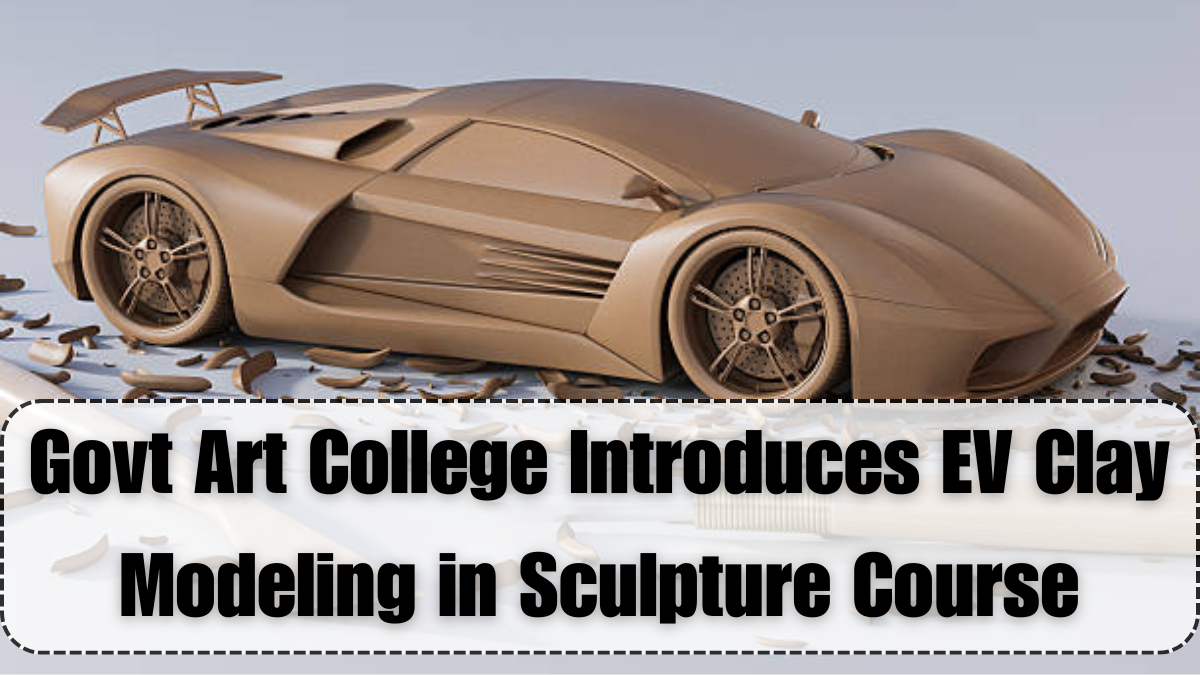EV modeling with clay is now an integral part of design education at the Government College of Art, where students are taking their first steps into electric vehicle design by sculpting 3D concepts entirely by hand. This new addition to the sculpture course blends traditional artistry with modern automotive innovation, offering young creators a chance to explore EV 3D design through tactile and visual expression.
The course module introduces students to the entire EV design process, beginning with concept sketches and evolving into full-scale clay model prototypes of electric cars. This hands-on training helps students understand body proportions, aerodynamics, and form development—skills that are foundational in the automotive industry. With EVs rapidly replacing internal combustion vehicles, colleges are adapting to ensure design students gain relevant experience in shaping the future of mobility.

Bringing Electric Mobility into Fine Arts
This initiative redefines what sculpture can mean in the 21st century. While clay sculpting has long been used in vehicle design studios, integrating EV modeling with clay into a fine arts curriculum is a progressive step. It not only teaches students technical modeling skills but also encourages them to think critically about form, function, and sustainability.
Key elements of the new course:
-
Hands-on clay model sculpting using industrial-grade materials
-
Study of EV chassis, battery layout, and weight distribution
-
Real-time feedback from design mentors and auto engineers
-
Emphasis on creating realistic, aerodynamic body designs
-
Incorporation of green themes into visual aesthetics
Each student completes a full design cycle — from 2D sketching to 3D clay shaping — ending with a fully-formed concept vehicle model.
Student Engagement and Design Philosophy
The EV 3D design experience has ignited a new level of enthusiasm among students. They not only gain a deeper understanding of vehicle proportions but also how each design choice affects performance and sustainability. Many have gone beyond cars, sculpting electric bikes, buses, and autonomous pods with intricate attention to detail.
Students benefit by:
-
Gaining real-world automotive design exposure
-
Practicing teamwork during joint clay projects
-
Building portfolios that reflect industry-relevant skills
-
Exploring how design can support electric and sustainable futures
-
Learning how to present and pitch design ideas effectively
The immersive nature of EV modeling with clay gives students the opportunity to apply theory to physical outcomes—bridging the gap between art and engineering.
A Future-Ready Design Curriculum
The inclusion of clay modeling has positioned the Government College of Art as a pioneer in blending traditional craftsmanship with future-focused education. Automotive designers from EV startups and design firms have praised the move, noting that tactile modeling is still a gold standard in design prototyping.
Faculty and guest instructors are now planning advanced workshops, where students will collaborate with local EV companies to design concept vehicles based on real-world briefs. With India’s EV sector expanding rapidly, this program is training the next generation of designers to think, feel, and shape the future through their hands and imagination.
FAQs
What is EV modeling with clay?
It involves sculpting three-dimensional electric vehicle designs using clay, helping students visualize and refine automotive shapes by hand.
Why is clay modeling still important in the EV 3D design process?
Despite digital tools, clay model sculpting allows designers to evaluate forms physically, making it a vital part of concept development.
Who can participate in the clay modeling course?
Students enrolled in the sculpture and industrial design programs at the Government College of Art can take this hands-on module.
What do students create in the course?
They build detailed EV 3D design models of cars, scooters, and futuristic electric vehicles using clay and design tools.
Are these models shared with the industry?
Yes, select models are displayed in college exhibitions and shared with EV companies for feedback and collaboration.
Click here to know more.
